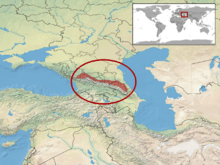Vipera lotievi
Vipera lotievi is a species of venomous snake in the family Viperidae. The species is endemic to Azerbaijan, Georgia, and Russia. There are no subspecies that are recognized as being valid.[4]
| Vipera lotievi | |
|---|---|
| Scientific classification | |
| Kingdom: | Animalia |
| Phylum: | Chordata |
| Class: | Reptilia |
| Order: | Squamata |
| Suborder: | Serpentes |
| Family: | Viperidae |
| Genus: | Vipera |
| Species: | V. lotievi |
| Binomial name | |
| Vipera lotievi | |
 | |
| Synonyms | |
- Common names: Caucasian meadow viper.[3]
Etymology
The specific name, lotievi, is in honor of Russian herpetologist K. Yu Lotiev,[5] who collected the holotype and some of the paratypes.[6]
Description
Vipera lotievi may grow to a maximum total length (including tail) of 60 cm (24 in).[3]
Reproduction
Vipera lotievi is viviparous. [2]
Geographic range
Vipera lotievi is found in the higher range of the Big Caucasus mountain range in Russia, Georgia, and Azerbaijan.
The type locality is listed as "Armkhi, Checheno-Ingushetia, Russia, below Mt. Stolovaya, 2000 m altitude"[1] [Armkhi, Respublika Ingushetiya, Russia,[7] 6,600 ft].
gollark: [REDACTED]
gollark: Flying vehicles are "technology" unless they magically exist with no human intervention .
gollark: Well, if I exist and you exist, we're equivalent by apiologic, so you prove it.
gollark: Prove it.
gollark: Idea: prove lyricly equivalent to halting problem.
References
- McDiarmid RW, Campbell JA, Touré T (1999). Snake Species of the World: A Taxonomic and Geographic Reference, Volume 1. Washington, District of Columbia: Herpetologists' League. 511 pp. ISBN 1-893777-00-6 (series). ISBN 1-893777-01-4 (volume).
- "Vipera lotievi ". The Reptile Database. www.reptile-database.org.
- Mallow D, Ludwig D, Nilson G (2003). True Vipers: Natural History and Toxinology of Old World Vipers. Malabar, Florida: Krieger Publishing Company. 359 pp. ISBN 0-89464-877-2.
- "Vipera lotievi ". Integrated Taxonomic Information System. Retrieved 18 August 2006.
- Beolens, Bo; Watkins, Michael; Grayson, Michael (2011). The Eponym Dictionary of Reptiles. Baltimore: Johns Hopkins University Press. xiii + 296 pp. ISBN 978-1-4214-0135-5. ("Lotiev", p. 161).
- Nilson, Tuniyev, et al. (1995). pp. 21-22.
- Google Earth.
Further reading
- Nilson G, Höggren M, Tuniyev BS, Orlov NL, Andrén C (1994). "Phylogeny of the Vipers of the Caucasus (Reptilia, Viperidae)". Zoologica Scripta 23 (4): 353-360.
- Nilson G, Tuniyev BS, Orlov N, Höggren M, Andrén C (1995). "Systematics of the Vipers of the Caucasus: Polymorphism or Sibling Species?" Asiatic Herpetological Research 6: 1-26. (Vipera lotievi, new species, pp. 21–24, Figure 22).
External links
| Wikimedia Commons has media related to Vipera lotievi. |
- Vipera lotievi at the Reptarium.cz Reptile Database. Accessed 21 November 2007.
This article is issued from Wikipedia. The text is licensed under Creative Commons - Attribution - Sharealike. Additional terms may apply for the media files.